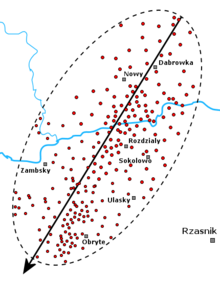- Streufeld
-
Als Streufeld wird ein Gebiet bezeichnet in dem sich Meteorite oder Tektite als Ergebnis eines Impakt verteilt haben. Auch Satelliten, die beim Wiedereintritt in die Atmosphäre zerbrechen, können ein Trümmerstreufeld erzeugen. Eine häufig vorgefundene geometrische Form des Streufeldes ist die sogenannte Streuellipse. Sie entsteht in aller Regel, da ein Meteoroid in einem Winkel auf die Erde trifft und in der Atmosphäre zerbricht (fragmentiert). Kleinere Bruchstücke haben im Verhältnis zur Oberfläche eine geringere Masse und werden daher durch den Luftwiderstand stärker abgebremst. Im Trümmerschwarm bleiben die kleinen Teile zurück und werden am meisten durch Wind beeinflusst. Die Bruchstücke verteilen sich in einer elliptischen Form, wobei die kleineren Stücke am Anfang der Ellipse fallen, während die größeren Meteorite das Ende markieren. Aus der Verteilung von Meteoritenmassen und der Form der Streuellipse kann somit die Richtung und der Eintrittswinkel des Meteoroiden annähernd rekonstruiert werden.
Quellen
- Hills, J. G.; Goda, M. P.: The fragmentation of small asteroids in the atmosphere, 1993 [1];
- Artemieva, N.; Pierazzo, E.: The Canyon Diablo impact event: Projectile motion through the atmosphere, 2009 [2];
- Ceplecha, Z.; Spurny, P.; Borovicka, J.; Keclikova, J.: Atmospheric fragmentation of meteoroids, 1993 [3];
- Ceplecha, Z.; Revelle, D. O.: Fragmentation model of meteoroid motion, mass loss, and radiation in the atmosphere, 2005 [4];
- Borovicka, J.; Popova, O. P.; Nemtchinov, I. V.; Spurn'y, P.; Ceplecha, Z.: Bolides produced by impacts of large meteoroids into the Earth's atmosphere: comparison of theory with observations. I. Benesov bolide dynamics and fragmentation, 1998 [5];
- Bronshten, Vitalij Aleksandrovich: Physics of meteoric phenomena, 1983, Lal, D.; Trivedi, J. R.: Observations on the spatial distribution of Dhajala meteorite fragments in the strewnfield, 1977 [6];
- Dod, B. D.; Sipiera, P. P.: Review of the Plainview, Texas Meteorite Finds with Additional Data on Strewnfield Distribution Patterns, 1988 [7]
Wikimedia Foundation.

